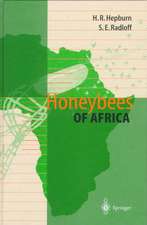Mutualisms and Insect Conservation
Autor Tim R. Newen Limba Engleză Hardback – 17 iul 2017
Documenting and understanding intricate ecological interactions involving insects is a central need in conservation, and the specialised and specific nature of many such associations is displayed in this book. Their importance is exemplified in a broad global overview of a major category of interactions, mutualisms, in which the interdependence of species is essential for their mutual wellbeing. The subtleties that sustain many mutualistic relationships are still poorly understood by ecologists and conservation managers alike. Examples from many parts of the world and ecological regimes demonstrate the variety of mutualisms between insect taxa, and between insects and plants, in particular, and their significance in planning and undertaking insect conservation – of both individual species and the wider contexts on which they depend. Several taxonomic groups, notably ants, lycaenid butterflies and sucking bugs, help to demonstrate the evolution and flexibility of mutualistic interactions, whilst fundamental processes such as pollination emphasise the central roles of, often, highly specific partnerships. This compilation brings together a wide range of relevant cases and contexts, with implications for practical insect conservation and increasing awareness of the roles of co-adaptations of behaviour and ecology as adjuncts to designing optimal conservation plans. The three major themes deal with the meanings and mechanisms of mutualisms, the classic mutualisms that involve insect partners, and the environmental and conservation lessons that flow from these and have potential to facilitate and improve insect conservation practice. The broader ecological perspective advances the transition from primary focus on single species toward consequently enhancing wider ecological contexts in which insect diversity can thrive.
| Toate formatele și edițiile | Preț | Express |
|---|---|---|
| Paperback (1) | 942.13 lei 6-8 săpt. | |
| Springer International Publishing – 12 aug 2018 | 942.13 lei 6-8 săpt. | |
| Hardback (1) | 948.16 lei 6-8 săpt. | |
| Springer International Publishing – 17 iul 2017 | 948.16 lei 6-8 săpt. |
Preț: 948.16 lei
Preț vechi: 1156.29 lei
-18% Nou
Puncte Express: 1422
Preț estimativ în valută:
181.43€ • 189.91$ • 151.01£
181.43€ • 189.91$ • 151.01£
Carte tipărită la comandă
Livrare economică 01-15 aprilie
Preluare comenzi: 021 569.72.76
Specificații
ISBN-13: 9783319582917
ISBN-10: 3319582917
Pagini: 232
Ilustrații: XII, 232 p. 52 illus.
Dimensiuni: 155 x 235 x 20 mm
Greutate: 0.52 kg
Ediția:1st ed. 2017
Editura: Springer International Publishing
Colecția Springer
Locul publicării:Cham, Switzerland
ISBN-10: 3319582917
Pagini: 232
Ilustrații: XII, 232 p. 52 illus.
Dimensiuni: 155 x 235 x 20 mm
Greutate: 0.52 kg
Ediția:1st ed. 2017
Editura: Springer International Publishing
Colecția Springer
Locul publicării:Cham, Switzerland
Cuprins
1 The Scope and Meaning of Mutualisms.- 2 Mechanisms and Maintenance.- 3 Classic Themes: Pollination Mutualisms of Insects and Plants.- 4 Classic Themes: Ants, Plants and Fungi.- 5 Classic Themes: Ants and Other Insects. Hemiptera.- 6 Classic Themes: Ants and Other Insects. Lepidoptera.- 7 Classic Themes: Other Insect Mutualisms.- 8 Impacts of Alien Invasive Species.- 9 Exploiters of Mutualisms.- 10 Habitat Losses and Conservation of Mutualisms.
Notă biografică
Emeritus Professor Tim New is an entomologist with broad interests in insect systematics, ecology and conservation. For long based at LaTrobe University, Melbourne, he has traveled widely to collect and study insects in many parts of the world, and his extensive publications on these topics include about 45 books. He is recognized globally as one of the leading advocates for insect conservation.
Textul de pe ultima copertă
Documenting and understanding intricate ecological interactions involving insects is a central need in conservation, and the specialised and specific nature of many such associations is displayed in this book. Their importance is exemplified in a broad global overview of a major category of interactions, mutualisms, in which the interdependence of species is essential for their mutual wellbeing. The subtleties that sustain many mutualistic relationships are still poorly understood by ecologists and conservation managers alike. Examples from many parts of the world and ecological regimes demonstrate the variety of mutualisms between insect taxa, and between insects and plants, in particular, and their significance in planning and undertaking insect conservation – of both individual species and the wider contexts on which they depend. Several taxonomic groups, notably ants, lycaenid butterflies and sucking bugs, help to demonstrate the evolution and flexibility of mutualisticinteractions, whilst fundamental processes such as pollination emphasise the central roles of, often, highly specific partnerships. This compilation brings together a wide range of relevant cases and contexts, with implications for practical insect conservation and increasing awareness of the roles of co-adaptations of behaviour and ecology as adjuncts to designing optimal conservation plans. The three major themes deal with the meanings and mechanisms of mutualisms, the classic mutualisms that involve insect partners, and the environmental and conservation lessons that flow from these and have potential to facilitate and improve insect conservation practice. The broader ecological perspective advances the transition from primary focus on single species toward consequently enhancing wider ecological contexts in which insect diversity can thrive.
Caracteristici
First global survey/interpretative overview of the varied mutualistic interactions in which insects participate, and their relevance in advancing insect conservation Examples and cases from many parts of the world and involving many taxa, many of them classic but others discovered only recently Complex ecological and conservation issues interpreted for non-specialist readers and, so, of practical value to managers; emphasis on ecological principles and their translation into practical conservation management



























